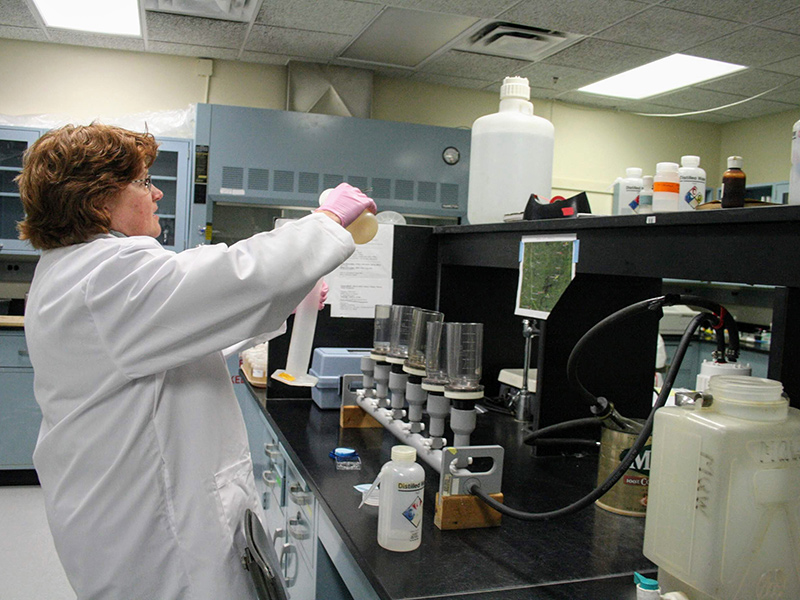
Lab Overview
Central Analytical Water Testing Lab
The NRRI Central Analytical Laboratory (CAL) has been in operation since 1987, providing analytical services and research support to a wide variety of partners and clients, including University of Minnesota scientists; local, state, tribal, and federal governmental agencies; private businesses; and commercial laboratories.
Lab Expertise
The NRRI CAL specializes in the analysis of low-level nutrients and water quality measures commonly encountered in the low nutrient lakes and streams located in the Upper Great Lakes region. Lab members are experts in studying the lakes and streams of northern Minnesota, and have been doing so for 3 decades.
Our lab excels at laboratory quality control practices and has extensive experience developing Quality Assurance Program Plans (QAPPs) for state and federally funded projects, including MPCA Surface Water Assessment (SWA) and Water Pollution Load Monitoring Network (WPLMN) Programs, USEPA funded Great Lakes Coastal Wetland Monitoring, and the USEPA funded Great Lakes Sediment Surveillance Program.
Lab Certifications
The NRRI CAL is certified for numerous Clean Water Act and Safe Drinking Water Act water quality measures by the Minnesota Pollution Control Agency’s Laboratory Certification Program. Certification follows National Environmental Laboratory Accreditation Program (NELAP) guidelines and requires annual Proficiency Testing through a secondary agency. The lab also participates in voluntary local, state and federal round robin quality assurance programs each year.
Rate Sheet
Water Quality Testing Services
Physical Analyses
- Color, apparent (spectrophotometric or visual)
- Color, true (add filtration)
- Specific Conductivity (µS/cm)
- Residue - Filterable (TDS)
- Residue - Total Suspended (TSS)
- Residue - Total
- Residue - Volatile (VSS) (includes TSS)
- Turbidity
Inorganics, non-metallics
- pH (standard)
- pH (closed head space)
- Acidity
- Alkalinity (end point)
- ANC (Gran plot)
- ANC + pH (closed head space)
- Chloride (FIA mercuric thiocyanate FIA )
- Sulfate
- Hardness as CaCO3
- Nitrogen
- Nitrogen Ammonia, dissolved (NH4-N)
- Nitrate + nitrite (Autoanalyzer) (NO3/NO2-N)
- Total (TN)
- TKN (by calculation; TN minus [NO3/NO2-N])
- Phosphorus
- Phosphate-ortho (OP, or SRP)
- Phosphorus-Total dissolved (DP)
- Phosphorus -Total (TP)
- Bioavailable Sediment TP
- TN + TP (simultaneous persulfate digestion)
- Silica, dissolved
Organics
- Carbon, total (TC)
- Carbon, total organic (TOC)
- Carbon, total organic (TOC), sediment (includes digestion)
- Carbon, dissolved organic (DOC)
Biological
- Chlorophyll-a with phaeophytin (Spectrophotometric or Fluorometric)
- Chlorophyll-a + b + c (Trichromatic)
- Algal composition analysis (rapid algal scan)
- Quantitative algal counts to species (with or without biovolume estimates)
- Zooplankton counts
- Total Coliforms (mpn)
- E. Coli (mpn)
Additional Services
- Sample filtration
- Digestions, non-routine
- Bottle preparation (per bottle)
- Bottle charges
- Sampling design consultation and development
- Quality Assurance Project Plan (QAPP) consultation
Lab Capabilities and Equipment
Key Equipment and Capabilities
- Flow Injection Autoanalyzer: Quantitative analysis of nutrients (low levels of all nitrogen and phosphorus fractions), silica, chloride, and sulfate
- Narrow band UV/VIS spectrophotometer: Quantitative colorimetric analysis for chlorophyll-a and phaeophytin, true or apparent color, low-level nitrogen and phosphorus
- Fluorometer: Quantitative analysis of algal pigments (chlorophyll-a and phycocyanin) and water movement tracers
- Total Organic Carbon Analyzer: Quantitative analysis of total and dissolved organic carbon
- Turbidimeters (bench and field): Quantitative analysis of turbidity
- pH meter/titration equipment: Quantitative analysis of alkalinity, acid neutralizing capacity, and hardness
- IDEXX Quanti-Tray System: Quantitative analysis of E. coli and Total Coliform bacteria
- Hydrolab and YSI multi-parameter water quality sondes, handheld field displays, Campbell Scientific dataloggers
- Limnological field sampling equipment for water, plankton, and sediment samples
Media Coverage
- – New robotic tool reduces repetitive analyses – Hometown Focus